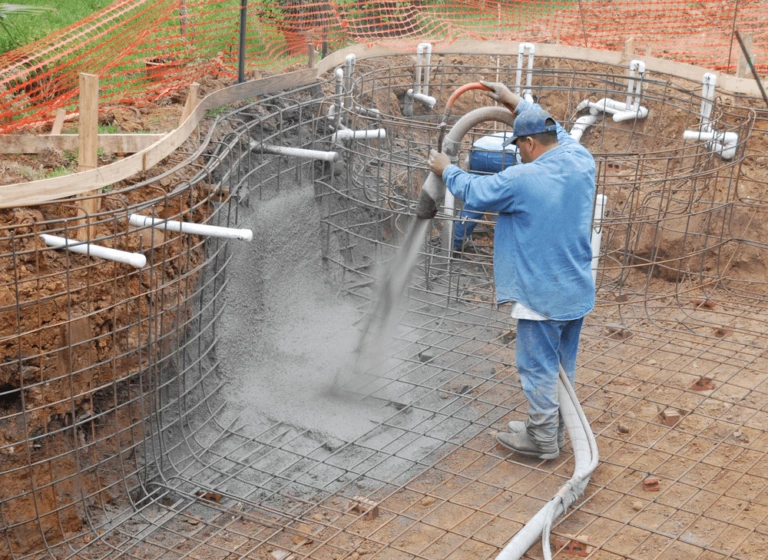
What are Gunite and Shotcrete?
If you’re researching inground pools or custom concrete structures, chances are you’ve come across the terms Gunite and Shotcrete. While they sound like technical jargon, they’re actually two of the most common methods used to build concrete pools. But what’s the difference? And does it really matter which one you choose?
In this post, we’ll break down what each material is, how they’re applied, and which might be better for your pool project.
The Basics: Gunite vs. Shotcrete
Both gunite and shotcrete are forms of sprayed concrete, applied pneumatically (with high pressure) over a rebar framework to build strong, durable pool shells. The main difference lies in how the concrete is mixed and applied.
What is Gunite?
Gunite is a dry-mix concrete. The dry cement and sand mixture is loaded into a hopper, then blasted through a hose using compressed air. Water is added only at the nozzle just before the material hits the surface.
- Mix type: Dry mix
- Water added: At the nozzle
- Popular for: Custom inground pools and curved surfaces
What is Shotcrete?
Shotcrete, on the other hand, is a wet-mix concrete. The cement, sand, aggregate, and water are pre-mixed before entering the hose and then sprayed onto the surface in one go.
- Mix type: Wet mix
- Water added: Pre-mixed before spraying
- Popular for: Pools, tunnels, retaining walls, and large-scale construction
Main Differences
- Application: Gunite allows for on-site water control, while shotcrete comes pre-mixed.
- Crew experience: Gunite requires a skilled nozzleman to get the water ratio right on the spot. Shotcrete is more consistent and easier to apply.
- Curing: Both need to be properly cured (kept moist for days after spraying) to avoid cracking.
- Time: Shotcrete is usually faster to apply but needs to be used immediately once mixed.
- Waste: Gunite tends to create more rebound (excess material falling off the wall).
Which Is Better for Your Pool?
Both materials are incredibly strong and durable when applied correctly. The “better” choice often depends on:
- Local contractor expertise: Many builders specialize in one method over the other.
- Project size and complexity: Gunite is great for freeform or highly customized shapes. Shotcrete is excellent for large, straight walls or quick builds.
- Scheduling: Shotcrete must be used immediately after mixing, while gunite can be staged more flexibly.
If you’re unsure which one to go with, ask your pool builder what they recommend based on your design, soil conditions, and budget.
Pros and Cons at a Glance
Gunite
- Pros: Great for custom shapes, flexible staging, strong when properly applied
- Cons: Requires experienced crew, water mix must be adjusted on-site, more waste
Shotcrete
- Pros: Consistent mix, faster application, less labor-sensitive
- Cons: Requires mixing truck, must be applied quickly, less flexible for complex shapes
Final Thoughts
Gunite and shotcrete are two sides of the same coin — both capable of creating a beautiful, long-lasting inground pool. The key difference lies in how the concrete is prepared and applied. If your builder has a strong track record with one method, trust their process. The results, when done right, are equally reliable.
